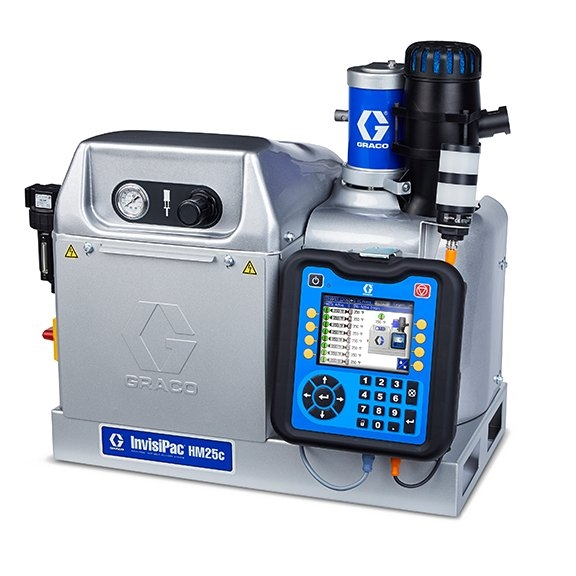Comparing the operation of packaging hot melt systems
How the hot melt process uses different technology
The operation cycle of a hot melt system consists of five crucial steps: feeding, melting, transferring, dispensing, and monitoring. While most hot melt systems on the market follow this principle of operation, it is the design and the technology used within the system where the biggest difference can be seen. We will compare the operation of the three main types of end-of-line packaging systems, tank-based, tank-less, and Graco's InvisiPac tank-free hot melt system.
Feeding
Traditional tank-based systems require adhesive to be fed manually, involving serious safety hazards for operators such as exposure to heated areas, molten adhesive, and toxic fumes.
Systems developed within the last 8 years, like the InvisiPac, have feeding capabilities where adhesive pellets are moved automatically from the container to the machine. This allows the operator to maintain a safe distance from possible burn exposure and eliminates the risk of inhaling toxic fumes. The hopper within Graco's InvisiPac feed bin remains fully enclosed, keeping adhesive free of debris and other contaminants.
InvisiPac's automatic feeding system feeds adhesive pellets solely based on the required output needed for the application. This makes it the industry's only true melt-on-demand system that maintains the integrity of hot melt material while reducing adhesive consumption for customers.
Melting
The melting process of hot melt systems is a critical step because, depending on the design of the system, the adhesive can be heated unevenly leading to increased char and issues further down the line. Both tank-based and tankless hot melt systems heat adhesive in a similar way, by bringing all the material up to operating temperature all at once, with the primary difference being that tankless systems have heated fins at the bottom of their tank. By bringing all the material up-to-temperature right away, it is common for overheating and adhesive charring of the adhesive to occur along with thermal shocking, which degrades the quality of the hot melt, leading to increased downtime and unplanned maintenance.
The true melt-on-demand technology of InvisiPac is designed to automatically add adhesive into the melting chamber as needed depending on the application's demand, eliminating the risk of adhesive charring and thermal shock occurring. The absence of a tank allows for the fastest start-up time (10 minutes) due to the melter design, which offers the highest melting ratio on the market.
Transferring
Next, the adhesive moves through the system's melting chamber to the hoses. It is standard feature with many tank-based and tankless systems on the market that they do not heat evenly throughout their hoses. This causes the hose to have hot spots where the temperature is higher in some places than in the rest of the hose. These hot spots change the viscosity of the adhesive, resulting in inconsistent dispensing while increasing material usage.
To combat these common issues in hot melt hoses, Graco’s InvisiPac heated hoses are made with an extra silicone layer that evenly distributes the heat within the hose, eliminating the occurrence of hot spots. By achieving a consistent temperature throughout the hose, the adhesive viscosity remains constant and the material’s integrity is not compromised. This ensures a constant flow of adhesive and results in lower maintenance and replacement costs.
Dispensing
Most tank-based and tankless systems on the market use applicators that, due to their design, allow adhesive to get stuck in the two corners causing what is known as “dead zones” to form. The stuck hot melt will eventually start to burn and clog the applicator or nozzle.
The applicators of Graco's InvisiPac have a free flow design that prevent dead zones from forming, which can lead to char build-up and eventually clog the nozzles. Instead, the adhesive is filtered by a unique double filtering system in the manifold and the module. As the temperature and viscosity are maintained from melter to applicator, every box gets a consistent dose of adhesive, avoiding expensive pop-opens and reducing adhesive usage by up to 70%.
Monitoring
The ability to stay in touch with your operation by viewing the status of your hot melt system allows you to be confident about the production quality while also observing real-time performance. Traditional tank and tank-less systems have limited solutions for monitoring critical system parameters and, with the rising cost of hot melt adhesive, the ability to track adhesive usage and keep lines running is a necessity.
Related Articles
Why InvisiPac is the reliable option for your packaging line?
An InvisiPac tank-free hot melt glue system with melt-on-demand process avoids charring and nozzle blocking.
What to consider when selecting a hot melt system
Five things to consider when selecting the hot melt system for your packaging operation.
What causes hot melt adhesive char
Overheating, contamination and oxidation. Learn about the three causes of adhesive char and how to avoid them.







